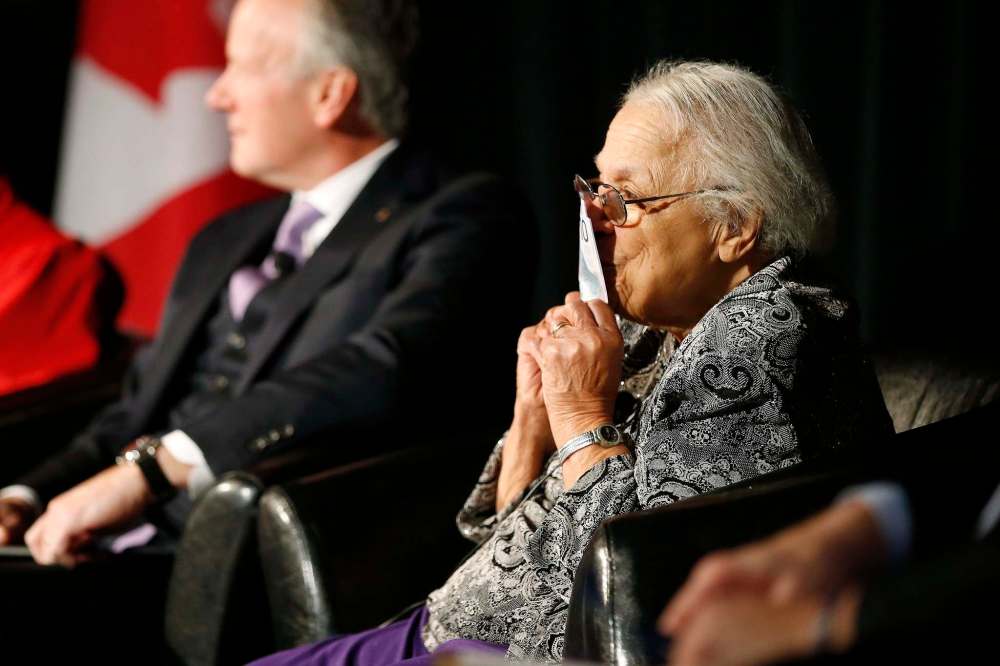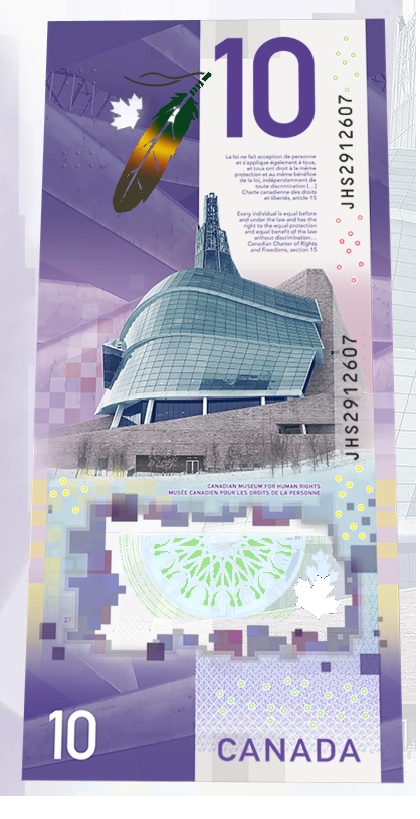New $10 bill makes history at human rights museum
Advertisement
Read this article for free:
or
Already have an account? Log in here »
To continue reading, please subscribe:
Monthly Digital Subscription
$0 for the first 4 weeks*
- Enjoy unlimited reading on winnipegfreepress.com
- Read the E-Edition, our digital replica newspaper
- Access News Break, our award-winning app
- Play interactive puzzles
*No charge for 4 weeks then price increases to the regular rate of $19.00 plus GST every four weeks. Offer available to new and qualified returning subscribers only. Cancel any time.
Monthly Digital Subscription
$4.75/week*
- Enjoy unlimited reading on winnipegfreepress.com
- Read the E-Edition, our digital replica newspaper
- Access News Break, our award-winning app
- Play interactive puzzles
*Billed as $19 plus GST every four weeks. Cancel any time.
To continue reading, please subscribe:
Add Free Press access to your Brandon Sun subscription for only an additional
$1 for the first 4 weeks*
*Your next subscription payment will increase by $1.00 and you will be charged $16.99 plus GST for four weeks. After four weeks, your payment will increase to $23.99 plus GST every four weeks.
Read unlimited articles for free today:
or
Already have an account? Log in here »
Hey there, time traveller!
This article was published 19/11/2018 (2548 days ago), so information in it may no longer be current.
A Canadian woman and a national museum are featured for the first time on a Bank of Canada note, as the new $10 bill was officially put into circulation Monday at the Canadian Museum for Human Rights.
The image of human rights pioneer Viola Desmond, the first woman other than the Queen and other royalty to appear on the front of a Canadian bank note, is on one side of the vertically oriented purple bill, and the Winnipeg-based CMHR is on the other.
Wanda Robson, Desmond’s younger sister, joined a slate of dignitaries to officially launch the historic piece of currency.

“I feel this is such a momentous occasion. It’s unbelievable. My sister, a woman — a black woman — is on the $10 bill,” said Robson, 91. “The Queen is in good company.”
Robson was joined by Bank of Canada governor Stephen Poloz and museum president and chief executive officer John Young.
“Canadians will now carry a story about human rights in their pockets,” Young said. “While Viola’s story is becoming increasingly known, the issuance of this bank note is another step, along with the museum, on our journey towards improving our collective memory and understanding that this is a story for all Canadians to know.”
Desmond was selected from some 25,000 nominations after an open call for Canadians to nominate a woman to be commemorated on the $10 bank note.
In 1946, the Nova Scotia businesswoman refused to leave the whites-only section of a theatre in New Glasgow, N.S. She was arrested, jailed and fined.
Her defiance helped motivate the struggle against racial segregation in Canada, and the story has been in an exhibit at the Winnipeg museum since it opened in 2014. Desmond (1914-65) received an official apology from Nova Scotia and free pardon from the lieutenant governor in 2010.
It was the first time a free pardon — which is based on innocence, and recognizes that a conviction was in error — had been posthumously granted in Canada.
Gail Asper, a CMHR trustee, said the museum began telling Desmond’s story in 2004 during a fundraising event called “Remember My Name” where actors appeared as famous Canadians to tell their human rights stories.

“An actor playing Viola Desmond came up and told the Viola Desmond story, which nobody really knew back in 2004. She said, ‘I am Viola Desmond. Remember my name.’ So 14 years later, to have Viola and the museum together on this day is incredibly fitting,” Asper said.
Robson said she hopes her sister’s story and the $10 bill help foster improved human rights and respect among all people. Asked what she things Desmond would say if she were here, Robson said: “It’s about time.”
“She would say that, to herself, ‘Well, it’s about time that somebody recognized what I did and what so many other people did in their own way. I did it in my way.’ That’s what she would think,” Robson said. “She would say there’s so many ordinary people that make a change or begin to make a change with a step here, a step here.”
Robson delighted the audience with her storytelling skills and her effervescent personality. She shared a memory of her sister’s powerful advocacy abilities from decades ago, when she was visiting Robson, a young mother at the time who was struggling financially; even though she’d asked authorities for help, her heat had been shut off.
Robson said Desmond crashed a town council meeting on a Saturday to ask for the heat to be turned back on for her little sister. When told to come back Monday, because the town office wasn’t open Saturdays, Desmond told the meeting: “Excuse me, children die on Saturday, also.”
“When we got home, the truck was there, the heat was in, the lights were on and there were groceries in my refrigerator,” Robson said.
Robson said she sees hope for the future in children when she speaks to them in schools about human rights.
“There. There is the change, in the children,” she said. “Children don’t see colour. They don’t see a difference. They have pals, they have friends. I’d like to keep it that way.”

Young said he hopes as Canadians learn more about Desmond’s story, they will also learn more about other stories of racism, oppression and injustice that are part of Canada’s human rights journey.
“Achieving rights for all is a process and we are not there yet,” Young said.
The new $10 bill is expected to be available in local banks within the next few weeks.
ashley.prest@freepress.mb.ca
History
Updated on Monday, November 19, 2018 3:07 PM CST: adds photos, fixes typo

